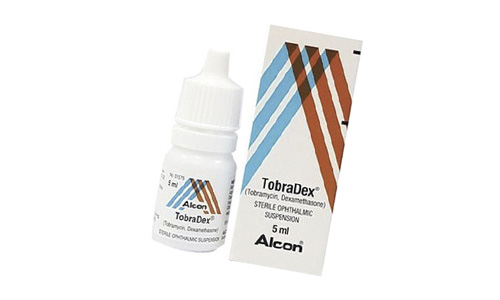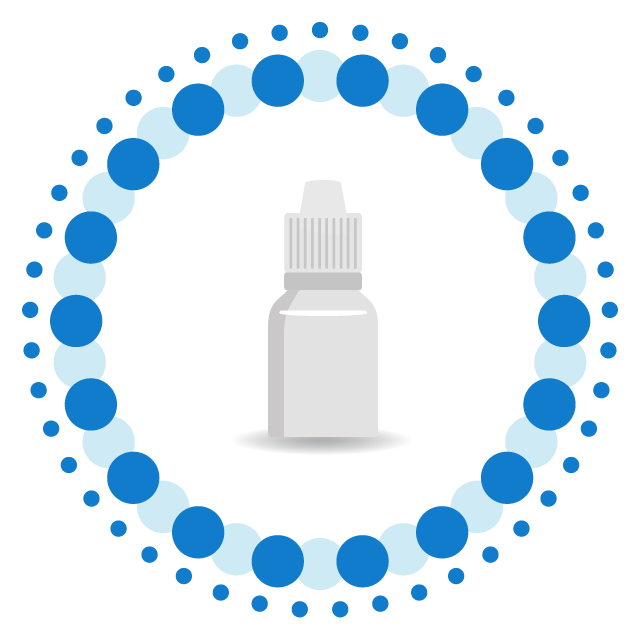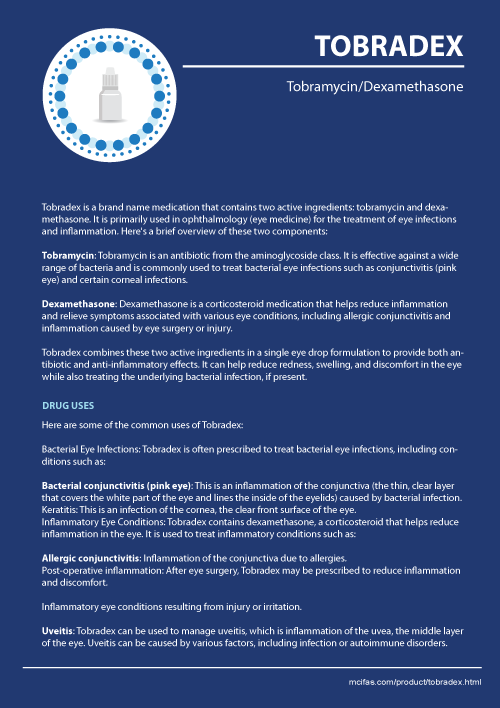Tobradex Prescribing Information
Tobradex is a brand name medication that contains two active ingredients: tobramycin and dexamethasone. It is primarily used in ophthalmology (eye medicine) for the treatment of eye infections and inflammation. Here's a brief overview of these two components:
- Tobramycin: Tobramycin is an antibiotic from the aminoglycoside class. It is effective against a wide range of bacteria and is commonly used to treat bacterial eye infections such as conjunctivitis (pink eye) and certain corneal infections.
- Dexamethasone: Dexamethasone is a corticosteroid medication that helps reduce inflammation and relieve symptoms associated with various eye conditions, including allergic conjunctivitis and inflammation caused by eye surgery or injury.
Tobradex combines these two active ingredients in a single eye drop formulation to provide both antibiotic and anti-inflammatory effects. It can help reduce redness, swelling, and discomfort in the eye while also treating the underlying bacterial infection, if present.

Uses of Tobradex
Here are some of the common uses of Tobradex:
Bacterial Eye Infections: Tobradex is often prescribed to treat bacterial eye infections, including conditions such as:
- Bacterial conjunctivitis (pink eye): This is an inflammation of the conjunctiva (the thin, clear layer that covers the white part of the eye and lines the inside of the eyelids) caused by bacterial infection.
Keratitis: This is an infection of the cornea, the clear front surface of the eye.
Inflammatory Eye Conditions: Tobradex contains dexamethasone, a corticosteroid that helps reduce inflammation in the eye. It is used to treat inflammatory conditions such as:
Allergic conjunctivitis: Inflammation of the conjunctiva due to allergies.
Post-operative inflammation: After eye surgery, Tobradex may be prescribed to reduce inflammation and discomfort.
Inflammatory eye conditions resulting from injury or irritation.
Uveitis: Tobradex can be used to manage uveitis, which is inflammation of the uvea, the middle layer of the eye. Uveitis can be caused by various factors, including infection or autoimmune disorders.
Dosage
The dosage of Tobradex can vary depending on the specific eye condition being treated and the severity of the condition. It is essential to follow your healthcare provider's prescription and instructions carefully. Below are some general guidelines for the dosing of Tobradex eye drops:
Bacterial Conjunctivitis:
- The usual recommended dose for adults and children over 1 year old is one or two drops in the affected eye(s) every 4 to 6 hours.
- Treatment typically continues for 7 to 14 days.
Other Inflammatory Eye Conditions (e.g., allergic conjunctivitis, post-operative inflammation):
- The dosing regimen for these conditions may vary based on the severity of inflammation.
- Typically, one or two drops are applied to the affected eye(s) every 4 to 6 hours.
- Treatment duration may vary, so follow your doctor's recommendations.
Side Effects of Tobradex
Tobradex can potentially cause side effects, just like any medication. It's essential to be aware of these side effects and report any unusual or severe reactions to your healthcare provider. Common side effects may include:
- Temporary Burning or Stinging: You may experience a mild burning or stinging sensation in your eyes when you apply the eye drops. This is usually temporary and should improve with continued use.
- Blurred Vision: Some people may experience temporary blurred vision immediately after applying Tobradex. Avoid activities like driving until your vision clears.
- Itching or Redness: In some cases, medicament may cause itching or increased redness in the eyes. This may be due to an allergic reaction to the medication.
- Increased Intraocular Pressure: Prolonged use of Tobradex, especially in susceptible individuals, can lead to increased intraocular pressure (IOP). This can be a concern for individuals with glaucoma.
- Eye Irritation: You may experience eye irritation, dryness, or discomfort while using this medicine.
- Prolonged Use Side Effects: Long-term or frequent use of Tobradex can increase the risk of developing side effects associated with corticosteroids, such as dexamethasone. These side effects may include cataract formation and an increased risk of eye infections.
- Allergic Reactions: While uncommon, some individuals may be allergic to Tobradex and can experience more severe allergic reactions, including swelling, itching, redness, or rash around the eye. If you notice these symptoms, stop using the medication and seek medical attention.
- Secondary Infections: Prolonged use of corticosteroid-containing eye drops like Tobradex can lead to the development of secondary fungal or bacterial infections.
Interaction with other drugs
Tobradex is an eye medication that is applied topically to the eye. Since it is administered locally to the eye, it generally has fewer interactions with other drugs compared to systemic medications. However, there are still some important considerations regarding potential interactions:
- Other Eye Medications: Using multiple eye medications simultaneously can dilute their effectiveness and may lead to interactions or reduced efficacy.
- Systemic Aminoglycoside Antibiotics: Tobramycin, one of the active ingredients in Tobradex, is an aminoglycoside antibiotic. If you are taking systemic (oral or intravenous) aminoglycoside antibiotics, it's important to inform your doctor.
- Corticosteroids: Dexamethasone, the other active ingredient in Tobradex, is a corticosteroid. When used in combination with other corticosteroid medications, there may be an increased risk of corticosteroid-related side effects, especially if used over an extended period.
What to avoid while on Tobradex
When using Tobradex, it's essential to follow your healthcare provider's instructions carefully to ensure the medication's effectiveness and minimize the risk of side effects. Here are some things to avoid or be cautious about while using eye drops:
- Touching the Eye Dropper: Always wash your hands before applying eye drops, and avoid touching the tip of the dropper to prevent contamination.
- Contact Lenses: If you wear contact lenses, remove them before applying Tobradex. You should wait at least 15 minutes after using the eye drops before reinserting your contact lenses. Some preservatives in eye drops can be absorbed by soft contact lenses, potentially causing eye irritation.
- Other Eye Medications: Leave a 10 to 15-minute interval between using different eye medications unless directed otherwise.
- Makeup and Cosmetics: While using Tobradex, it's a good idea to avoid eye makeup or cosmetics in the affected eye(s) as these products can introduce contaminants or interfere with the medication's absorption.
- Wearing Eye Protection: If your eye condition or treatment requires eye protection (e.g., an eye shield or goggles), follow your doctor's recommendations to prevent further irritation or injury.
- Driving and Operating Machinery: Tobramycin and Dexamethasone may cause temporary blurred vision immediately after use. If your vision is affected, it's best to avoid activities like driving or operating heavy machinery until your vision clears.
- Sharing Medication: Do not share Tobradex with others, even if they have similar eye conditions. It's a prescription medication intended for the specific individual it was prescribed to.
- Prolonged Use: Do not use Tobradex for a longer duration than prescribed, as prolonged use can increase the risk of side effects.
- Alcohol-Based Eye Drops: Avoid using alcohol-based eye drops simultaneously with Tobradex, as they may increase the risk of eye irritation.
- Allergens and Irritants: Minimize exposure to allergens or irritants that could exacerbate your eye condition while using Tobradex. This may include avoiding dust, smoke, and other potential allergens.
- Alcohol: There are no known interactions between Tobradex eye drops and alcohol.
Contraindications of Tobradex
Tobradex is a prescription medication used to treat various eye conditions. While it can be effective for many individuals, there are certain contraindications, or situations in which its use is not recommended or should be avoided. Here are some contraindications:
- Hypersensitivity or Allergy: Medicine should not be used by individuals who have a known hypersensitivity or allergy to any of its active ingredients (tobramycin or dexamethasone) or to any of the components in the formulation. Allergic reactions can be severe and include symptoms such as itching, redness, swelling, or rash. If you suspect an allergic reaction, discontinue use and seek medical attention.
- Viral Eye Infections: Tobramycin and Dexamethasone is not appropriate for the treatment of viral eye infections, such as herpes simplex keratitis or viral conjunctivitis. It is an antibiotic-corticosteroid combination intended to treat bacterial infections and reduce inflammation, not viral infections.
- Fungal Eye Infections: Tobradex should not be used to treat fungal eye infections. It is not effective against fungal pathogens and may worsen fungal infections.
- Untreated Bacterial Infections: Drug should not be used if there is a suspicion of a bacterial eye infection that has not been properly diagnosed or if there is uncertainty about the nature of the eye condition. The use of Tobradex without a confirmed bacterial infection can contribute to antibiotic resistance and is not recommended.
- Glaucoma: Individuals with a history of glaucoma or elevated intraocular pressure (IOP) should use Tobradex with caution and under the close supervision of an ophthalmologist. The corticosteroid component (dexamethasone) can elevate IOP, potentially worsening glaucoma.
- Herpes Simplex Virus (HSV) Infection: Tobradex should be used with caution in individuals with a history of ocular herpes simplex virus (HSV) infection, as corticosteroids can exacerbate this condition.
- Tuberculosis (TB) Infection: Systemic use of corticosteroids like dexamethasone can exacerbate or reactivate tuberculosis (TB) infections. While the risk of systemic effects from topical ophthalmic corticosteroids is low, individuals with active or latent TB should be cautious when using this drug.
- Children Under 1 Year Old: Tobradex is generally not recommended for use in children under 1 year of age without specific guidance.
Pregnancy and Tobradex
Pregnant individuals should exercise caution when using Tobradex or any medication. Here are some important points to consider:
- Topical Application: Tobradex is applied topically to the eye and has limited systemic absorption. This means that less of the medication enters the bloodstream compared to medications taken orally or systemically. This reduced systemic absorption may decrease the potential risk to the developing fetus, but it does not eliminate it entirely.
- Corticosteroid Risks: The dexamethasone component of Tobradex is a corticosteroid. Prolonged or systemic use of corticosteroids during pregnancy can be associated with potential risks, including the possibility of low birth weight, cleft lip and palate, and other developmental issues. However, the use of corticosteroids in topical ophthalmic form is generally associated with lower systemic exposure.
» Drug Uses (format pdf, 0.2 Mb)



